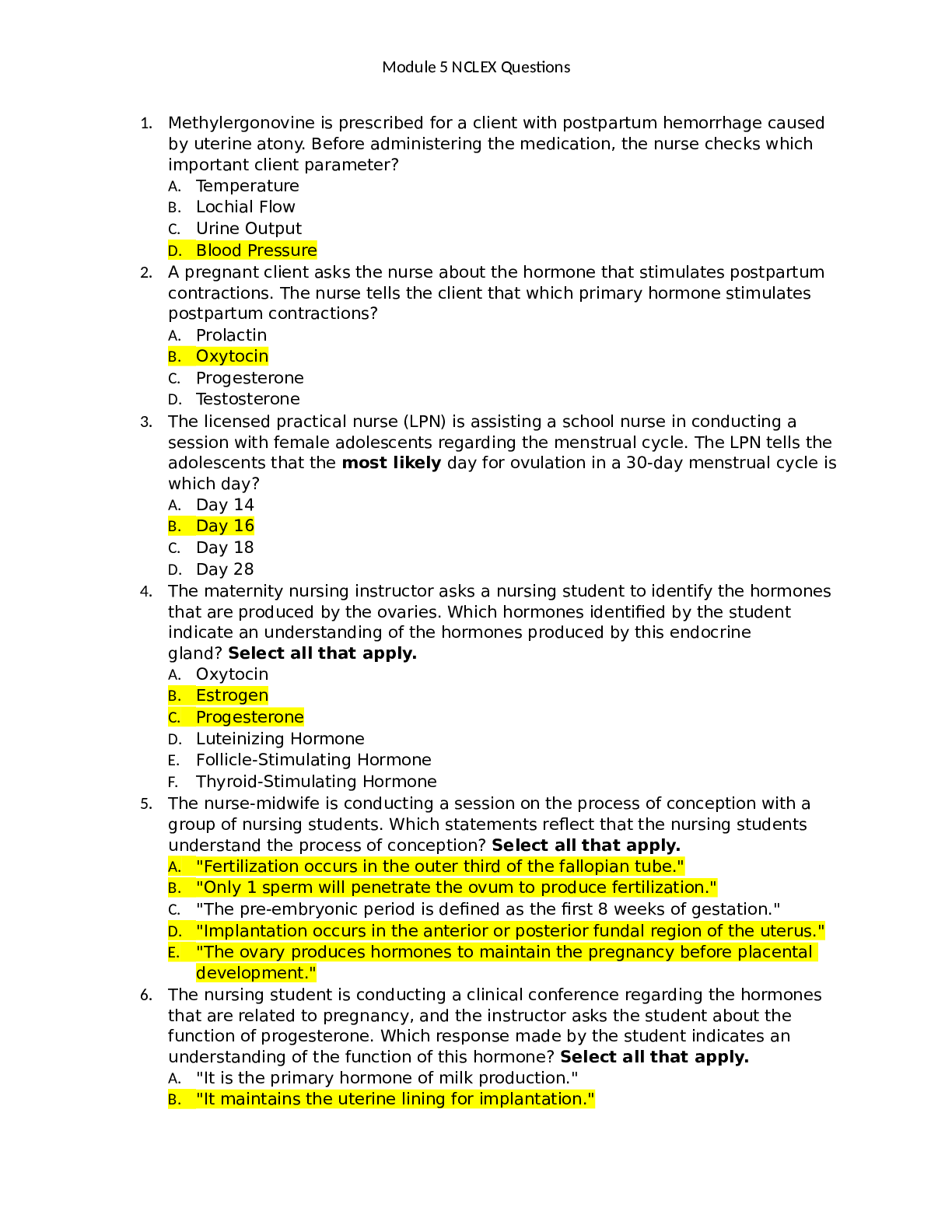*NURSING > NCLEX > MED SURG 206 Comprehensive Foundation NCLEX Questions And Answers( All Answers Are Correct)Top score (All)
MED SURG 206 Comprehensive Foundation NCLEX Questions And Answers( All Answers Are Correct)Top score
Document Content and Description Below
Comprehensive Foundation NCLEX Question 1 100 / 100 pts The client with cellulitis of the lower leg has had cultures done on the affected area. The nurse reviewing the results of the culture repor t i... nterprets that which of the following organisms is not part of the normal flora of the skin? Staphylococcus epidermidis Correct! Escherichia coli Candida albicans Staphylococcus aureus Rationale: E. coli is normally found in the intestines and is a common source of infection of wounds and the urinary system. C. albicans, S. aureus, and S. epidermis are part of the normal flora of the skin. Test-Taking Strategy: To answer this question correctly, you must be familiar with the normal microorganisms that inhabit the skin. Note that the question asks for the organism that is not part of normal flora. Remember that E. coli is normally found in the intestines. Review basic skin structures if you had difficulty with this question. Question 2 100 / 100 pts The client has been diagnosed with paronychia. The nurse understands that this is a disorder of the: Pilosebaceous glands Correct! Nails Hair follicles Epithelial layer of skin Rationale: Paronychia is a fungal infection that is most often caused by Candida albicans. This results in inflammation of the nail fold, with separation of the fold from the nail plate. The area is generally tender to touch, with purulent drainage. Disorders of the hair follicles include folliculitis, furuncles, and carbuncles. Disorders of the pilosebaceous glands include acne vulgaris and seborrheic dermatitis. There are a variety of disorders involving the epithelial skin. Test-Taking Strategy: To answer this question accurately, you must be familiar with a variety of skin disorders and their causes. Remember that paronychia is a nail disorder. If this question was difficult, review the characteristics of paronychia. Question 3 100 / 100 pts The nurse is assigned to the care of a client scheduled for surgery for a right colon tumor. Which of the following is the most characteristic manifestation of cancer at this site? Correct! Dull abdominal pain exacerbated by walking Flat, ribbon-like stools Crampy gas pains Frequent diarrhea Rationale: Characteristic symptoms of right colon tumors include vague, dull, abdominal pain exacerbated by walking, and dark red- or mahogany-colored blood mixed in the stool. The symptoms described in the other options are associated with left colon tumors. Test-Taking Strategy: Knowledge regarding the signs of right and left colon tumors is required to answer this question. Note, however, that “crampy gas pains” and “dull abdominal pain exacerbated by walking” describe different patterns of pain. This may suggest to you that one of the two is correct. If you are not familiar with the differences between right and left colon tumors, review this content. Question 4 100 / 100 pts The client with an endocrine disorder complains of weight loss and diarrhea, and says that he can “feel his heart beating in his chest.” The nurse interprets that which of the following glands is most likely responsible for these symptoms? Parathyroid Pituitary Correct! Thyroid Adrenal cortex Rationale: The thyroid gland is responsible for a number of metabolic functions in the body, including metabolism of nutrients (such as fats and carbohydrates). Increased metabolic function places a demand on the cardiovascular system for a higher cardiac output. Thus, a client with increased activity of the thyroid gland exhibits weight loss from higher metabolic rate and increased pulse rate. Test-Taking Strategy: Use knowledge of the function of the thyroid gland to answer this question. Remember that the thyroid gland is responsible for metabolic function. This will assist in directing you to “thyroid.” If you had difficulty answering this question, review the function of the thyroid gland. Question 5 100 / 100 pts The client with diabetes mellitus is being tested to determine long-term diabetic control. Which of the following results would the nurse expect to see if the client’s long-term control is within acceptable limits? Fasting blood glucose level of 150 mg/dL Correct! Glycosylated hemoglobin of 6% Presence of albumin in the urine Presence of ketones in the urine Rationale: This measurement of glycosylated hemoglobin (Hb A1c) detects glucose binding on the red blood cell (RBC) membrane and is expressed as a percentage. It measures glucose for the life of the RBC, which is 120 days. The fasting blood glucose level should be lower than 130 mg/dL. The urine should be free of both ketones and urine. Test-Taking Strategy: Specific knowledge of the effects of an increased blood glucose level in the body is necessary to answer this question. Noting the words “long-term” will direct you to “glycosylated hemoglobin of 6%.” Review the alterations in normal physiology that occur with diabetes mellitus if you had difficulty with this question. Question 6 100 / 100 pts Discharge teaching for a client recovering from an attack of chronic pancreatitis should include which of the following instructions? Diet should be high in carbohydrates, fats, and proteins. Frothy fatty stools indicate that enzyme replacement is working. Alcohol should be consumed in moderation. Correct! Avoid caffeine, because it may aggravate symptoms. Rationale: Knowing that caffeinated beverages, such as coffee, tea, and soda, will worsen symptoms, such as pain, will direct you to select “Avoid caffeine, because it may aggravate symptoms.” Alcohol can precipitate an attack of chronic pancreatitis and needs to be avoided. The recommended diet is moderate carbohydrates, low fat, and high protein. Frothy fatty stools indicate that the replacement enzyme dose needs to be increased. Test-Taking Strategy: “Alcohol should be consumed in moderation” can be immediately eliminated because alcohol can precipitate another attack and needs to be avoided. “Diet should be high in carbohydrates, fats, and proteins” can be eliminated because the recommended diet is moderate carbohydrates, low fat, and high protein. Finally, frothy fatty stools indicate that the enzyme dose needs to be increased, so “frothy fatty stools indicate that enzyme replacement is working” can be eliminated. Review home care instructions for the client with chronic pancreatitis if you had difficulty answering this question. Question 7 100 / 100 pts A client returns to the nursing unit after undergoing an esophagogastroduodenoscopy (EGD). Which of the following reflects appropriate intervention by the nurse? Correct! Withhold oral fluids until the client’s gag reflex has returned. Tell the client to report a sore throat immediately, because it is a serious complication. Allow the client unassisted bathroom privileges. Keep the client lying flat in bed in the supine position. Rationale: In preparation for the passage of the endoscope, an anesthetic is sprayed to inactivate the gag reflex and thus facilitate passage of the tube. It may take 1 to 2 hours for the anesthetic spray to wear off and for the gag reflex to return. “Allow the client unassisted bathroom privileges,” “keep the client lying flat in bed in the supine position,” and “tell the client to report a sore throat immediately, because it is a serious complication” are incorrect. Test-Taking Strategy: Apply knowledge of endoscopic procedures of the upper gastrointestinal tract to assist you with selecting the correct option. Because the client will receive conscious sedation for the procedure and anesthetic spray to the throat, postprocedure safety precautions must be maintained. This includes assistance to the bathroom and head of the bed elevation to prevent aspiration of oral secretions. A sore throat is common postprocedure and may persist for a few days but is not a cause for alarm. Review these postprocedural instructions if you had difficulty with this question. Question 8 100 / 100 pts A client presents to the urgent care center with complaints of abdominal pain and vomits bright red blood. Which of the following is the priority action taken by the nurse? Perform a complete abdominal assessment. Obtain a thorough history of the recent health status. Prepare to insert a nasogastric tube and test pH and occult blood. Correct! Take the client’s vital signs. Rationale: The nurse should take the client’s vital signs first to determine whether the client is hypovolemic or in shock from blood loss; this also provides a baseline blood pressure and pulse by which to gauge the effectiveness of treatment. Signs and symptoms of shock include low blood pressure, rapid weak pulse, increased thirst, cold clammy skin, and restlessness. Test-Taking Strategy: The strategic word in the question is “priority.” This tells you that more than one or all of the options may be partially or totally correct. Although all the options may be applicable to the care of this client, use principles of priority setting to answer the question. A client with an acute upper gastrointestinal (GI) bleed is at risk for shock. From the options provided, taking the client’s vital signs is the nursing action that will provide information about the status of the client’s circulating volume status. Review care to the client with a GI bleed if you had difficulty with this question. Question 9 100 / 100 pts The chest x-ray report for a client states that the client has a left apical pneumothorax. The nurse would monitor the status of breath sounds in that area by placing the stethoscope: In the fifth intercostal space Near the lateral 12th rib Posteriorly, under the left-sided scapula Correct! Just under the left-sided clavicle Rationale: For the client with a left apical pneumothorax, the nurse would place the stethoscope just under the left clavicle. The apex of the lung is the rounded uppermost part of the lung. All the other options are incorrect. Test-Taking Strategy: Knowledge of anatomical landmarks is needed to answer this basic question. Noting the client’s diagnosis and the strategic words “left apical” will direct you to “just under the left-sided clavicle.” If needed, review assessment of the client with a left apical pneumothorax. Question 10 100 / 100 pts A client’s total cholesterol level is 344 mg/dL, low-density lipoprotein cholesterol (LDL-C) level is 164 mg/dL, and high-density lipoprotein cholesterol (HDL-C) level is 30 mg/dL. Based on analysis of the data, how should the nurse direct client teaching? Correct! The client is at high risk for cardiovascular disease, and measures to modify all identified risk factors should be taught. The client should maintain the current dietary regimen but increase activity levels. Results are inconclusive unless the triglyceride level is also screened, so teaching is not indicated at this time. The client is at low risk for cardiovascular disease, so the client should be encouraged to continue to follow the current regimen. Rationale: In the absence of documented cardiovascular disease, the desired goal is to have the total cholesterol level lower than 200 mg/dL. A desired LDL-C level for all individuals is lower than 100 mg/dL, and a desirable HDL-C level is higher than 40 mg/dL. Because the client’s levels are outside the range for all three values to a significant degree, the client is at high risk for developing cardiovascular disease and requires teaching on risk factor reduction. Test-Taking Strategy: Use knowledge of normal values for serum cholesterol and lipoprotein levels to answer this question. The question does not indicate that the client has documented heart disease, so the standard recommended values apply. Knowing that the total cholesterol should be lower than 200 mg/dL helps you choose your answer correctly. Review the risk factors for cardiovascular disease if you had difficulty answering this question. Question 11 100 / 100 pts The nurse identifies that a client is having occasional premature ventricular contractions (PVCs) on the cardiac monitor. The nurse reviews the client’s laboratory results and determines that which of the following results would be consistent with the observation? Serum chloride level of 95 mEq/L Correct! Serum potassium level of 2.8 mEq/L Serum sodium level of 150 mEq/L Serum calcium level of 11.5 mg/dL Rationale: [Show More]
Last updated: 1 year ago
Preview 1 out of 119 pages
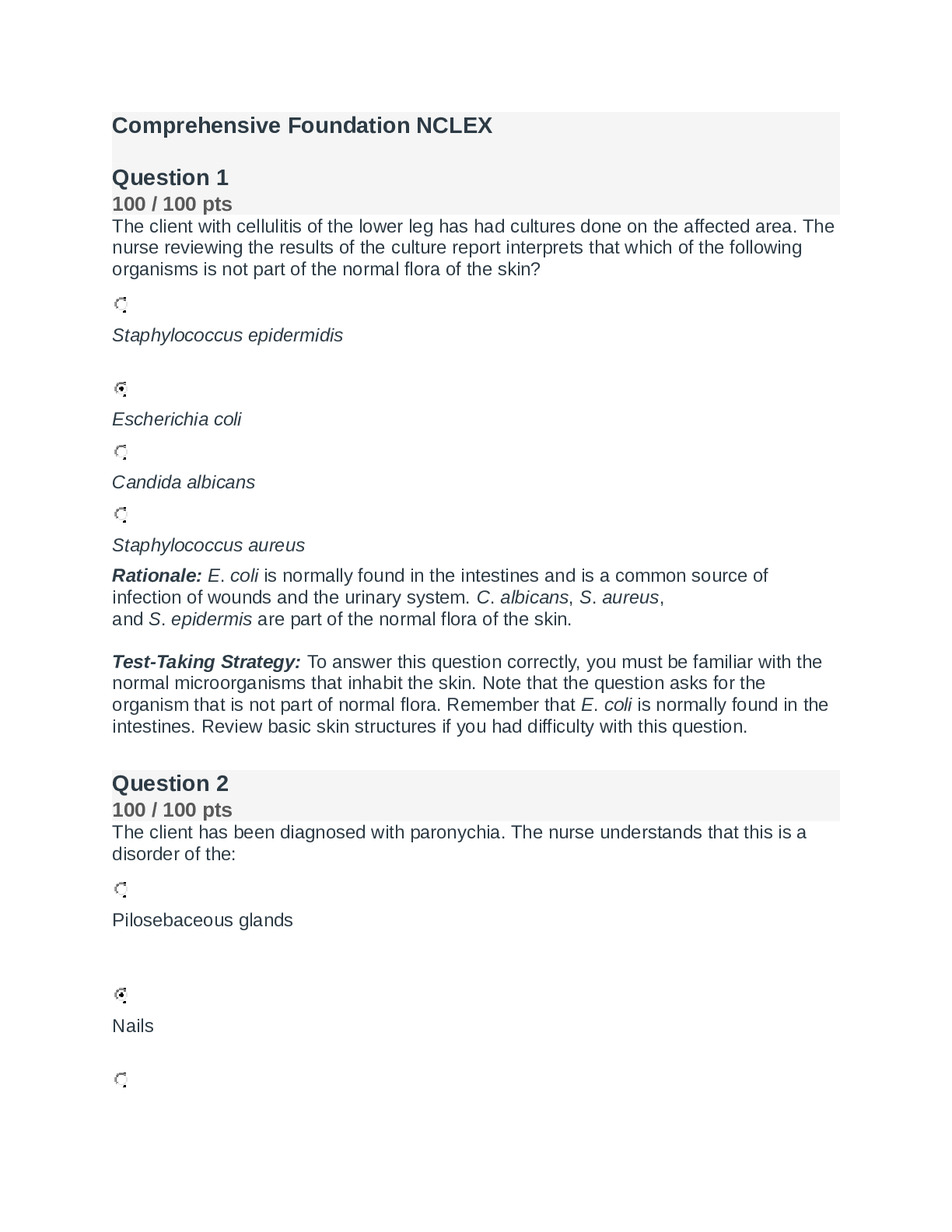
Reviews( 0 )
Document information
Connected school, study & course
About the document
Uploaded On
Mar 15, 2022
Number of pages
119
Written in
Additional information
This document has been written for:
Uploaded
Mar 15, 2022
Downloads
0
Views
54


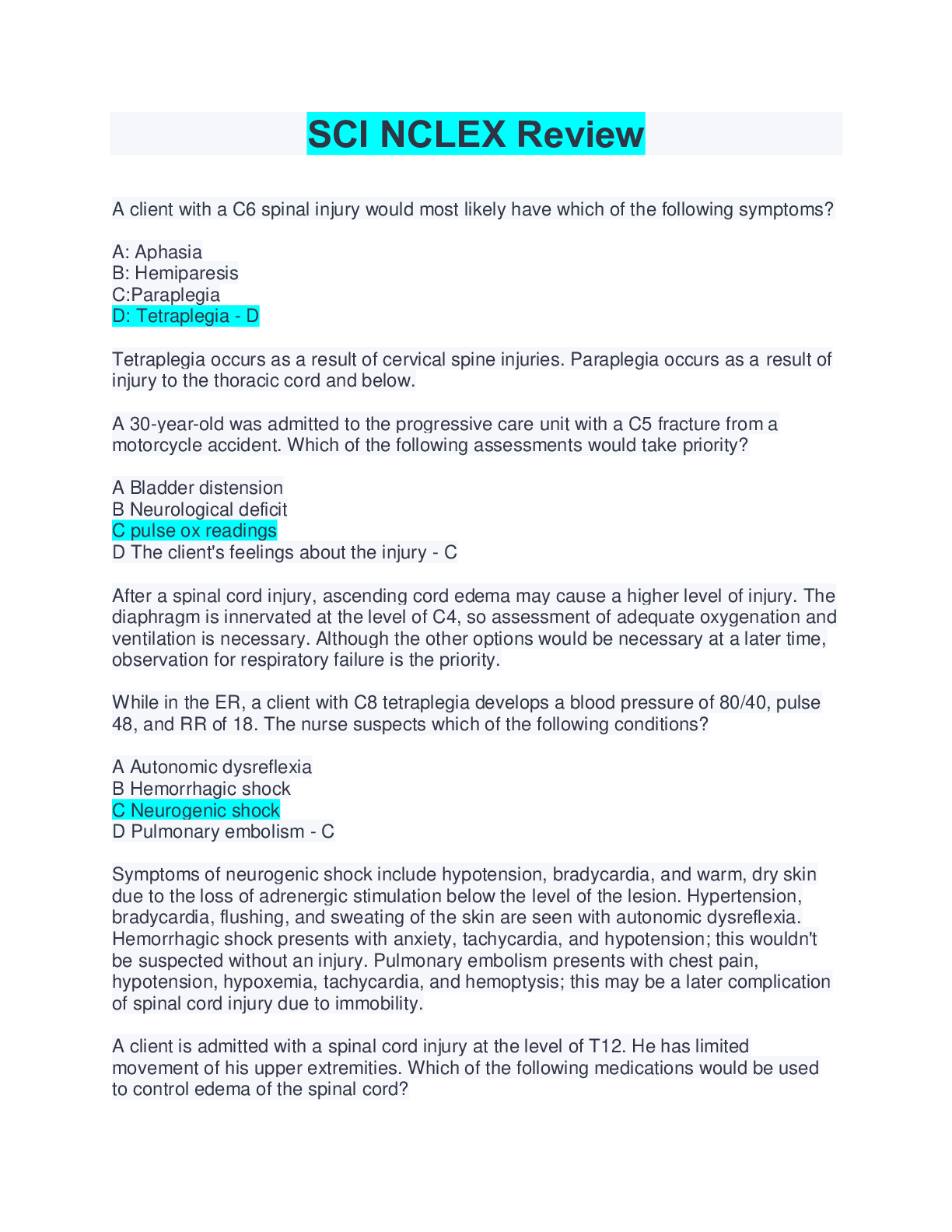

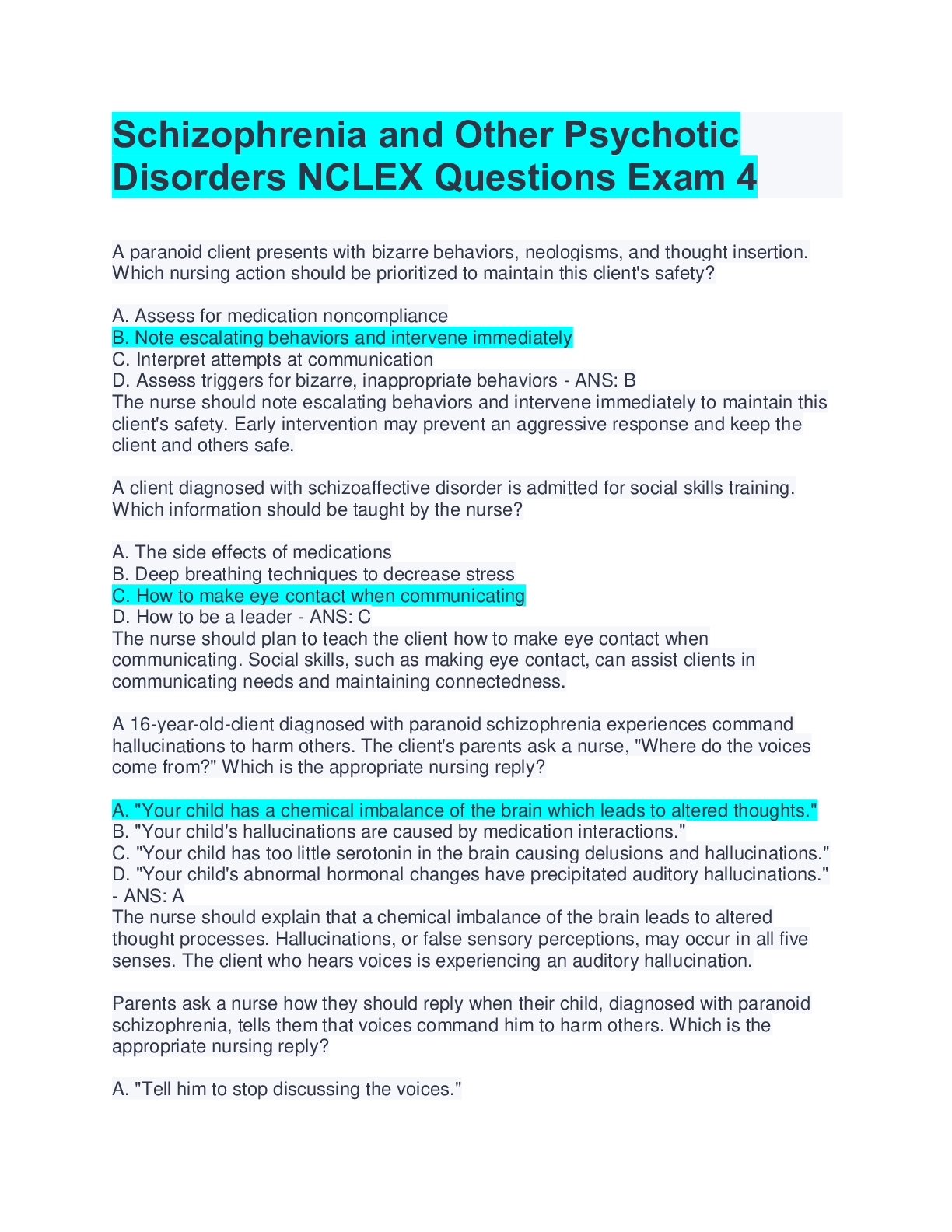
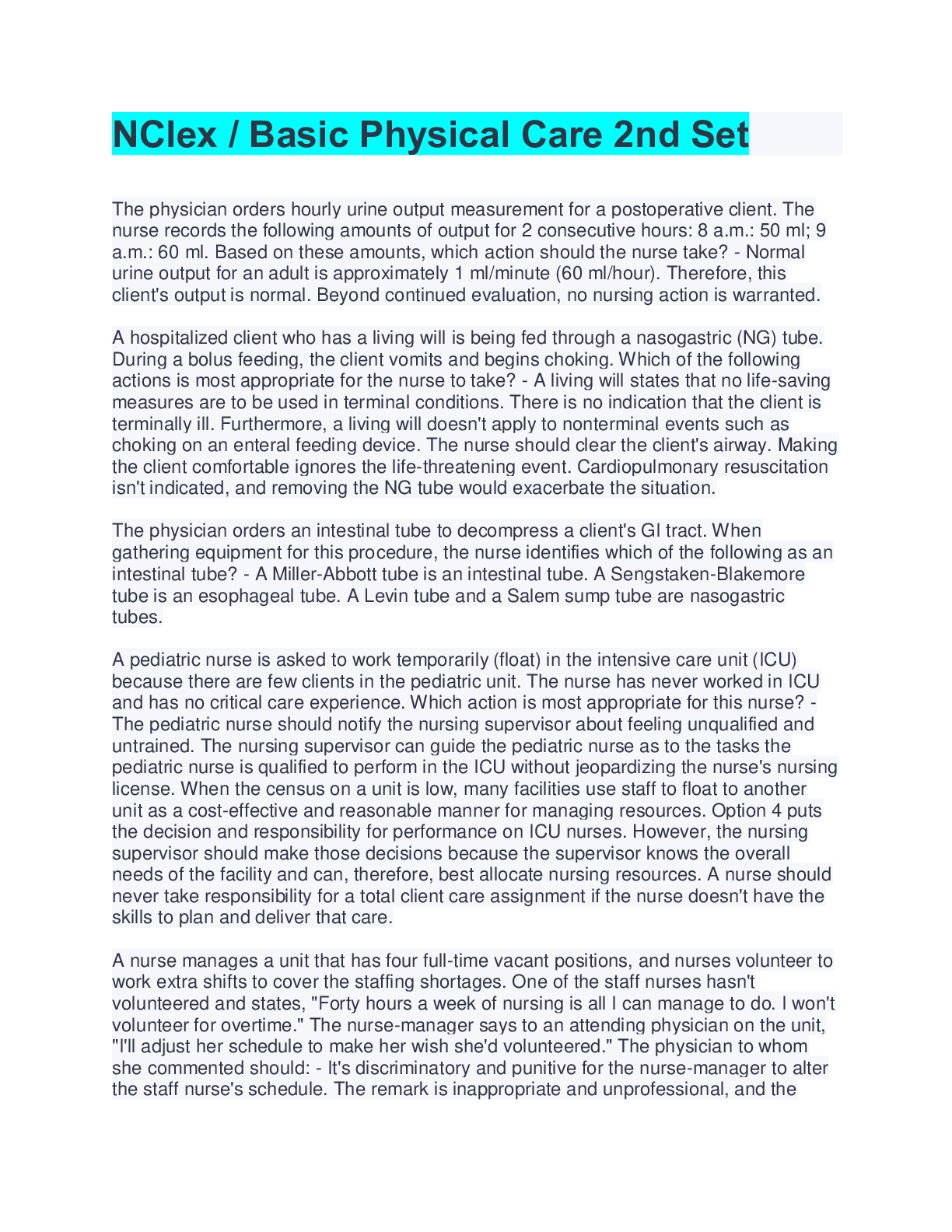
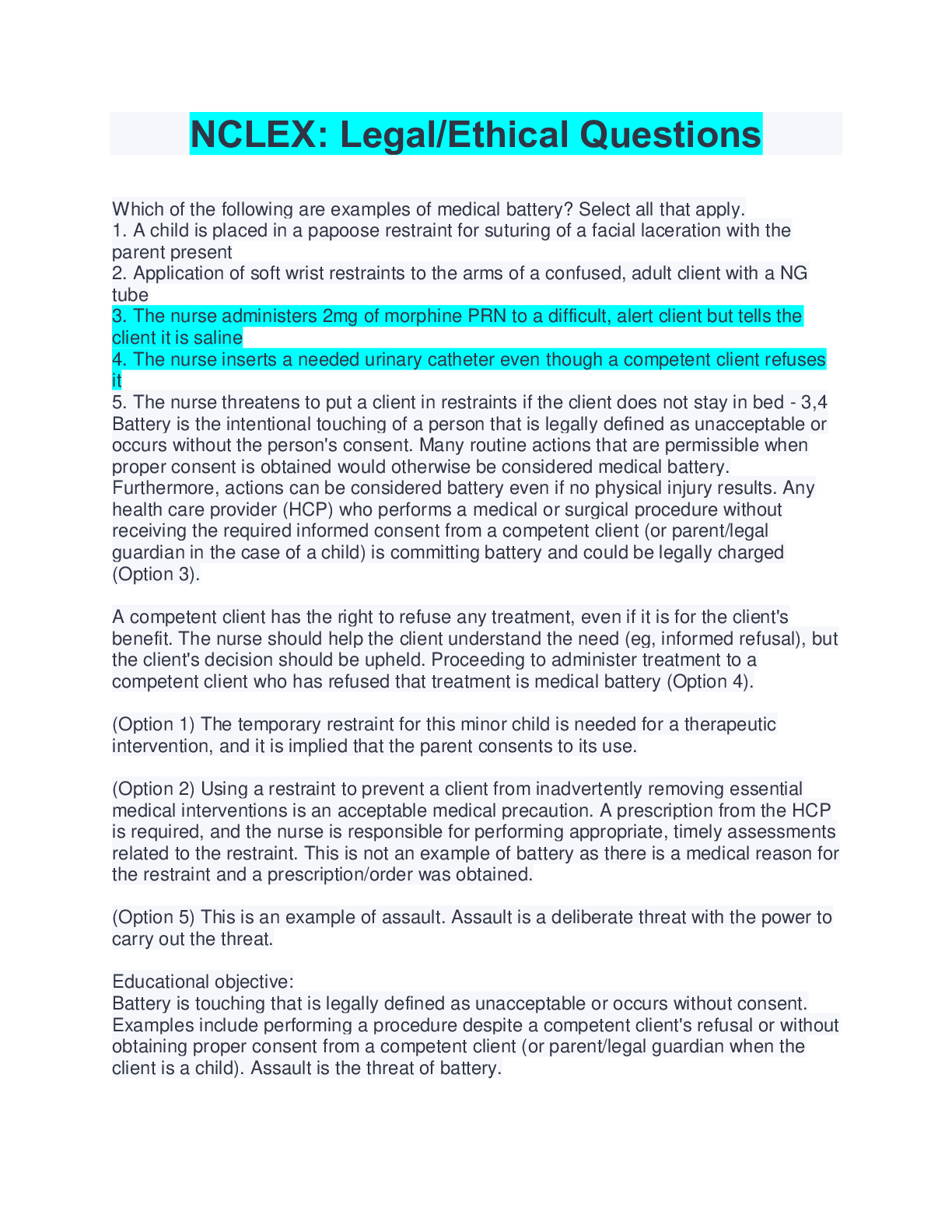

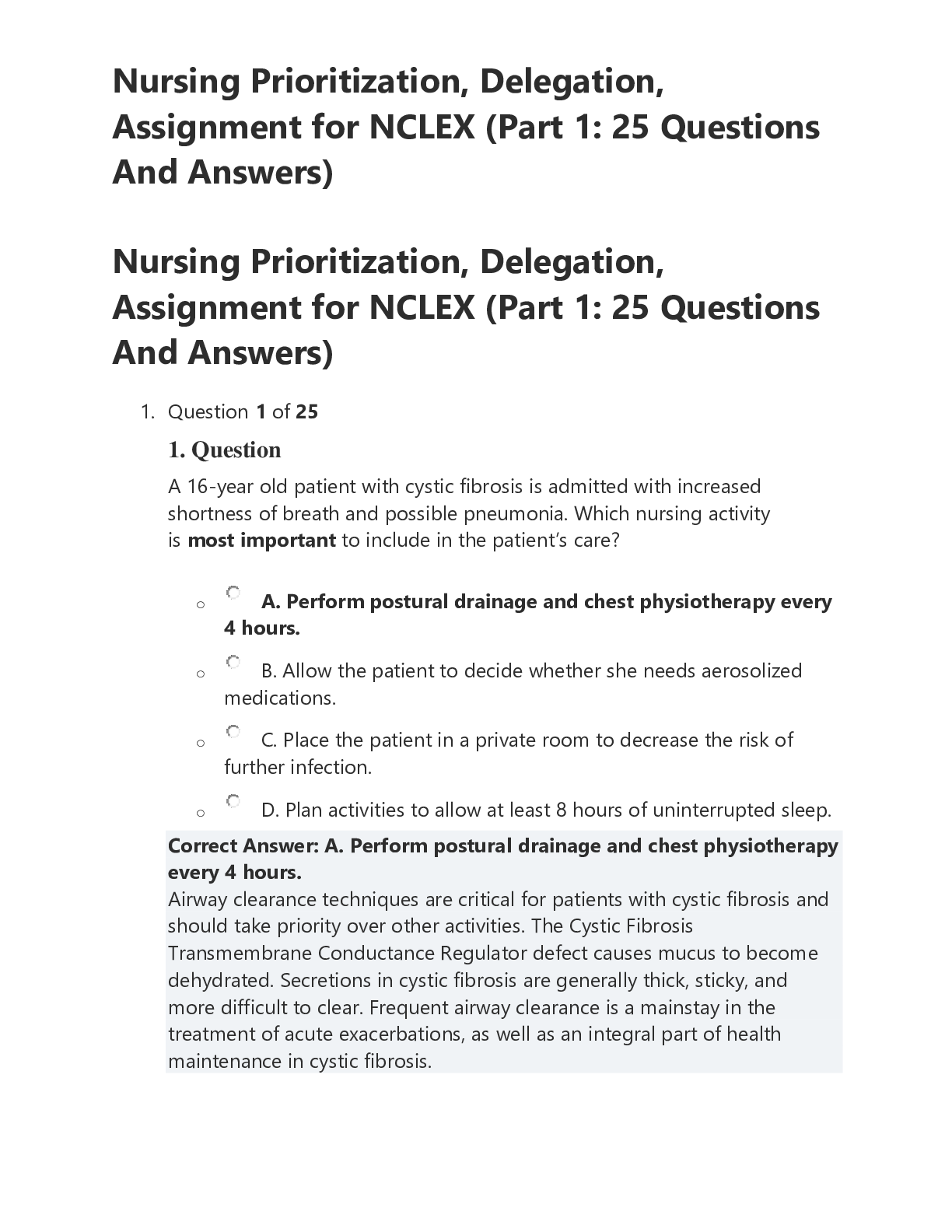
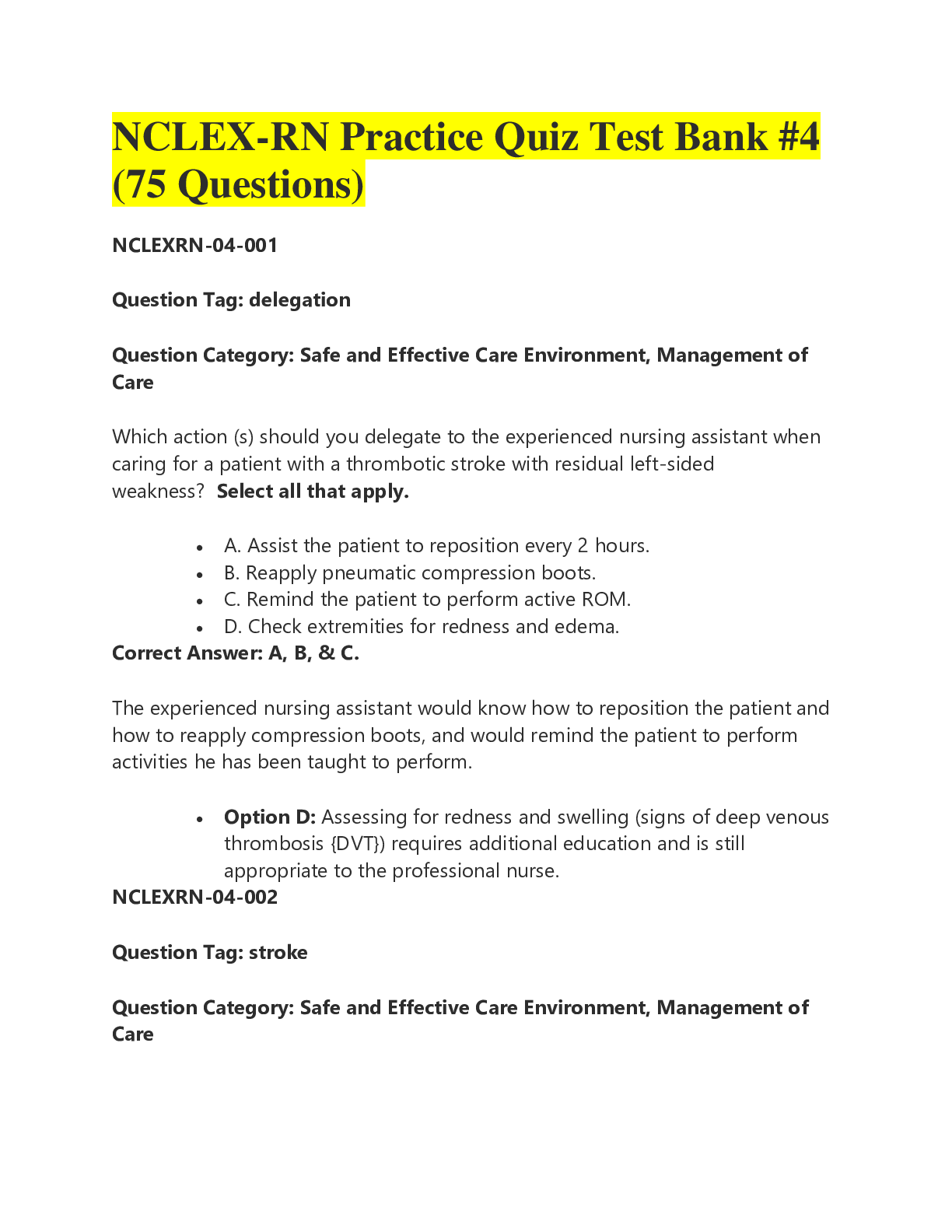
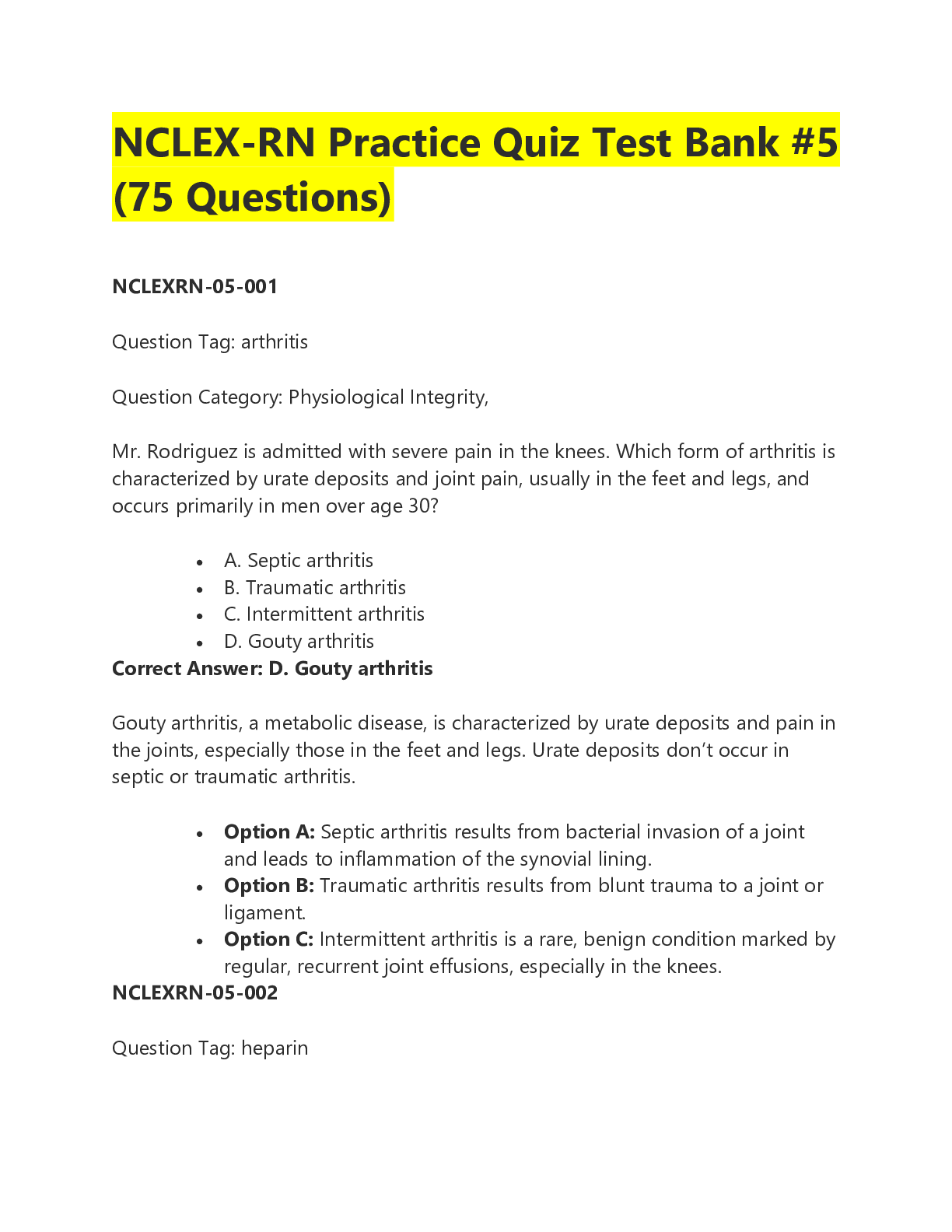
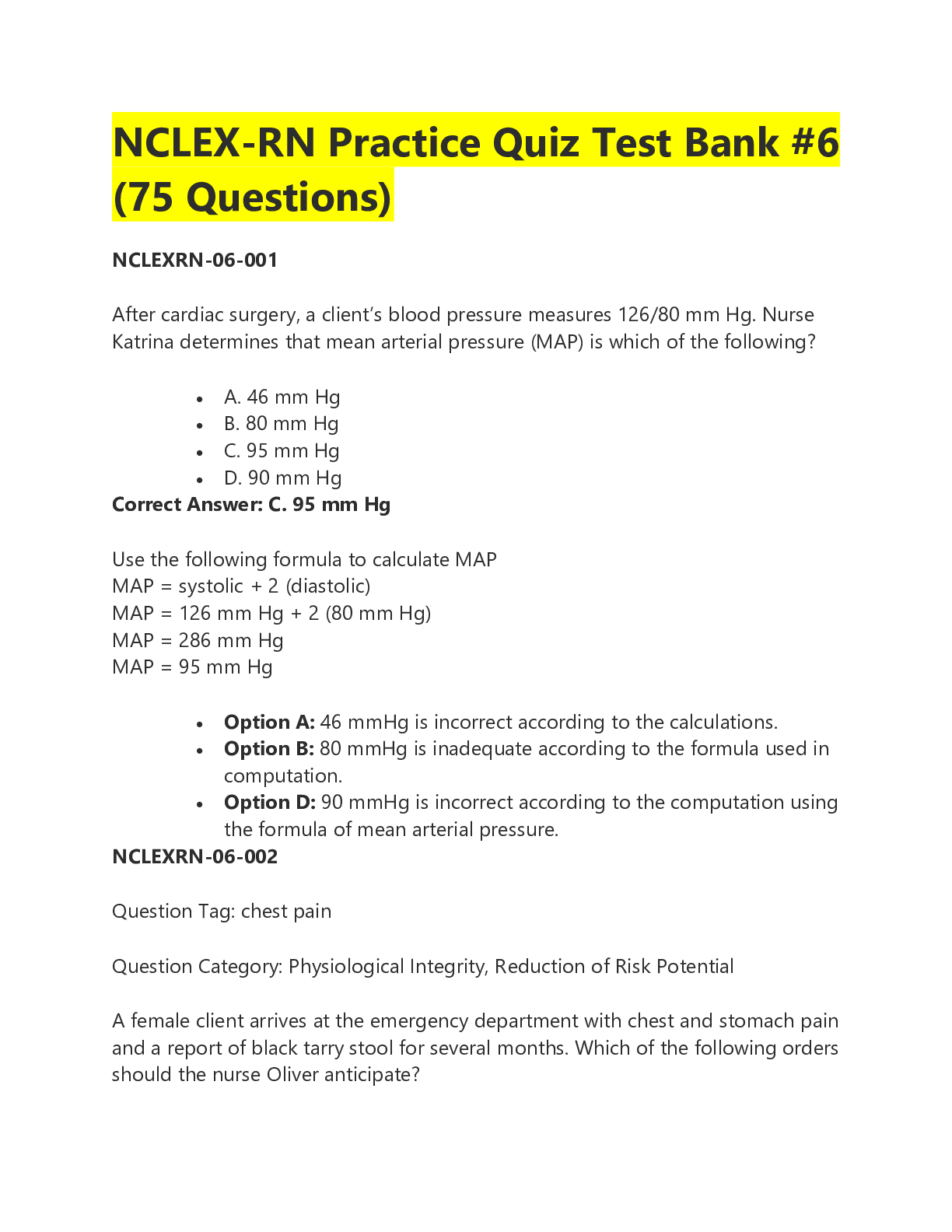

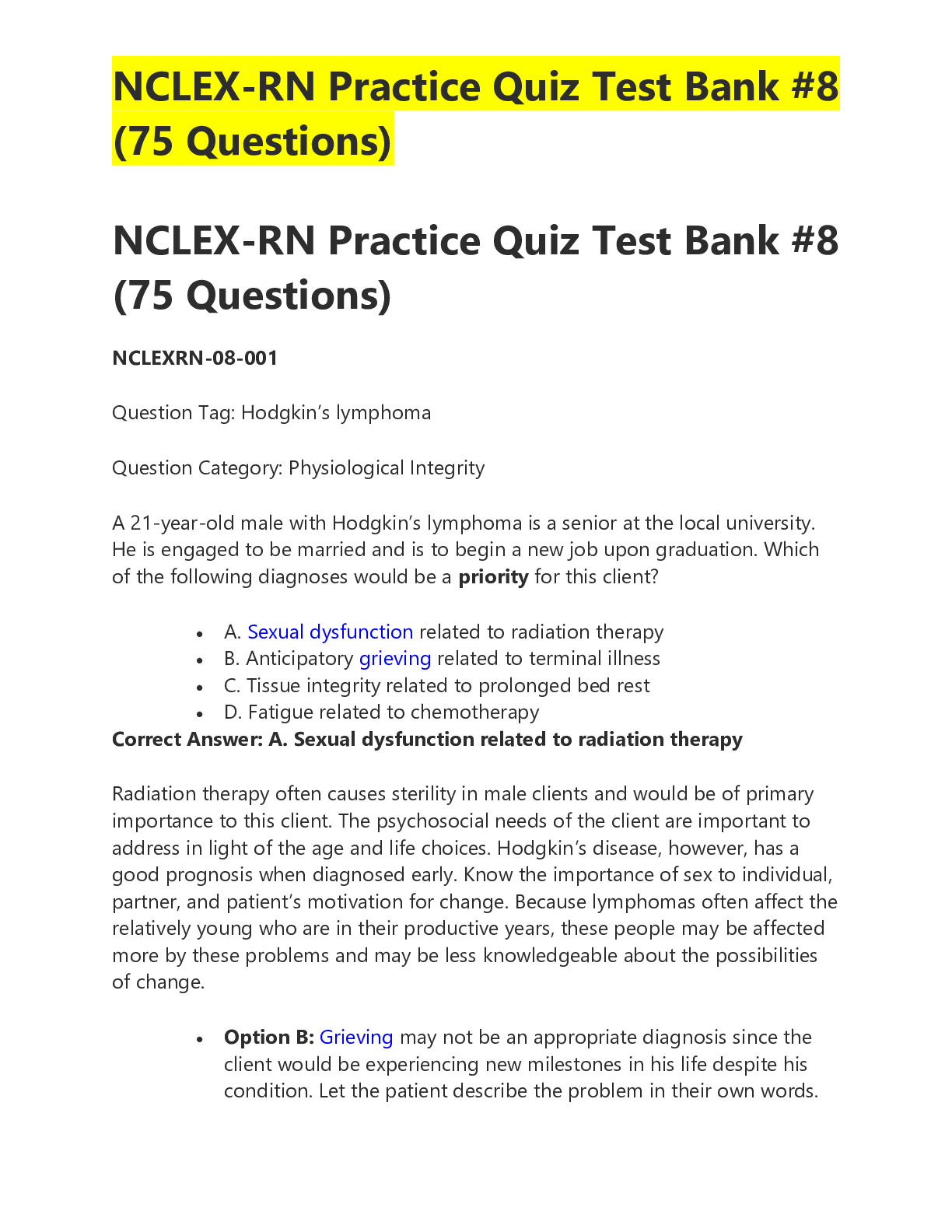

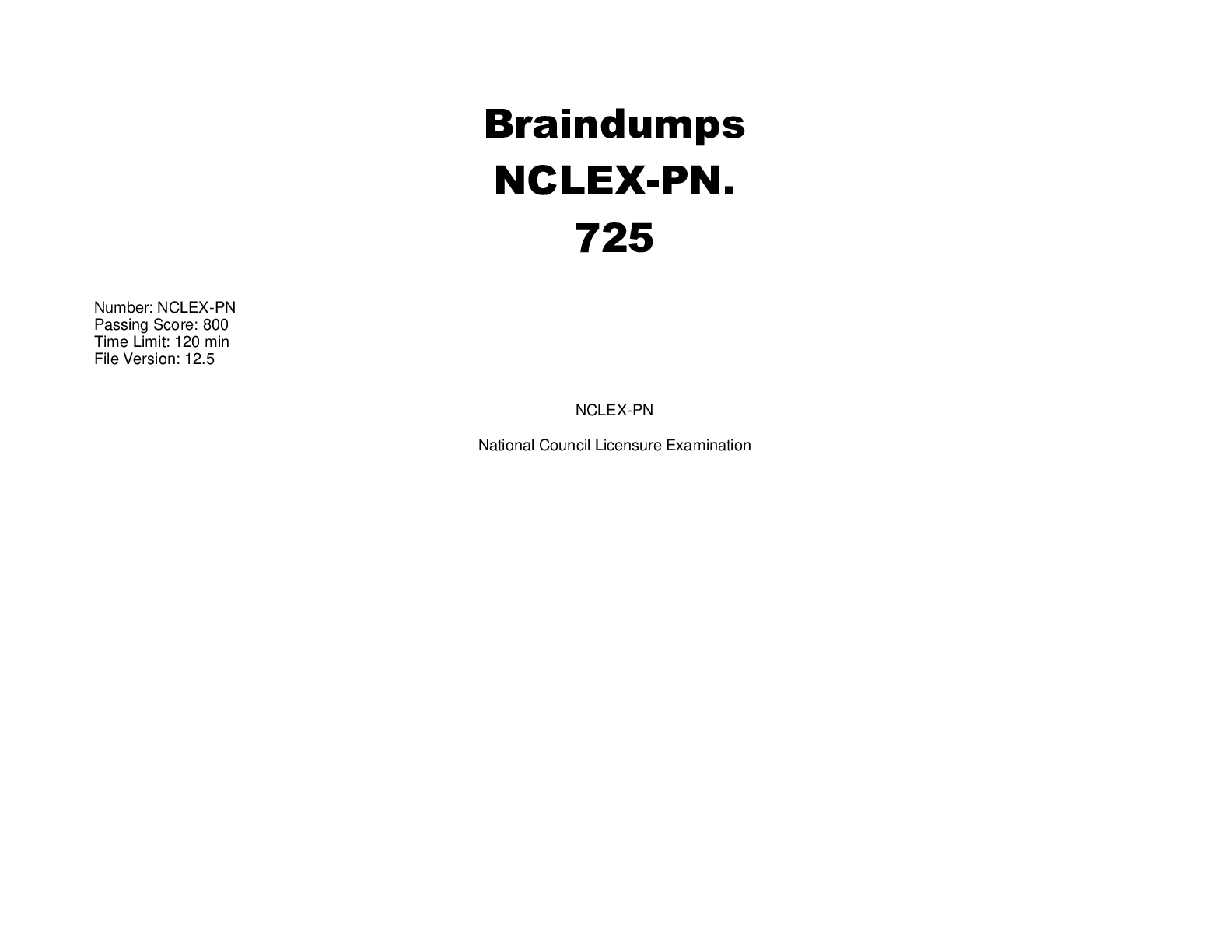
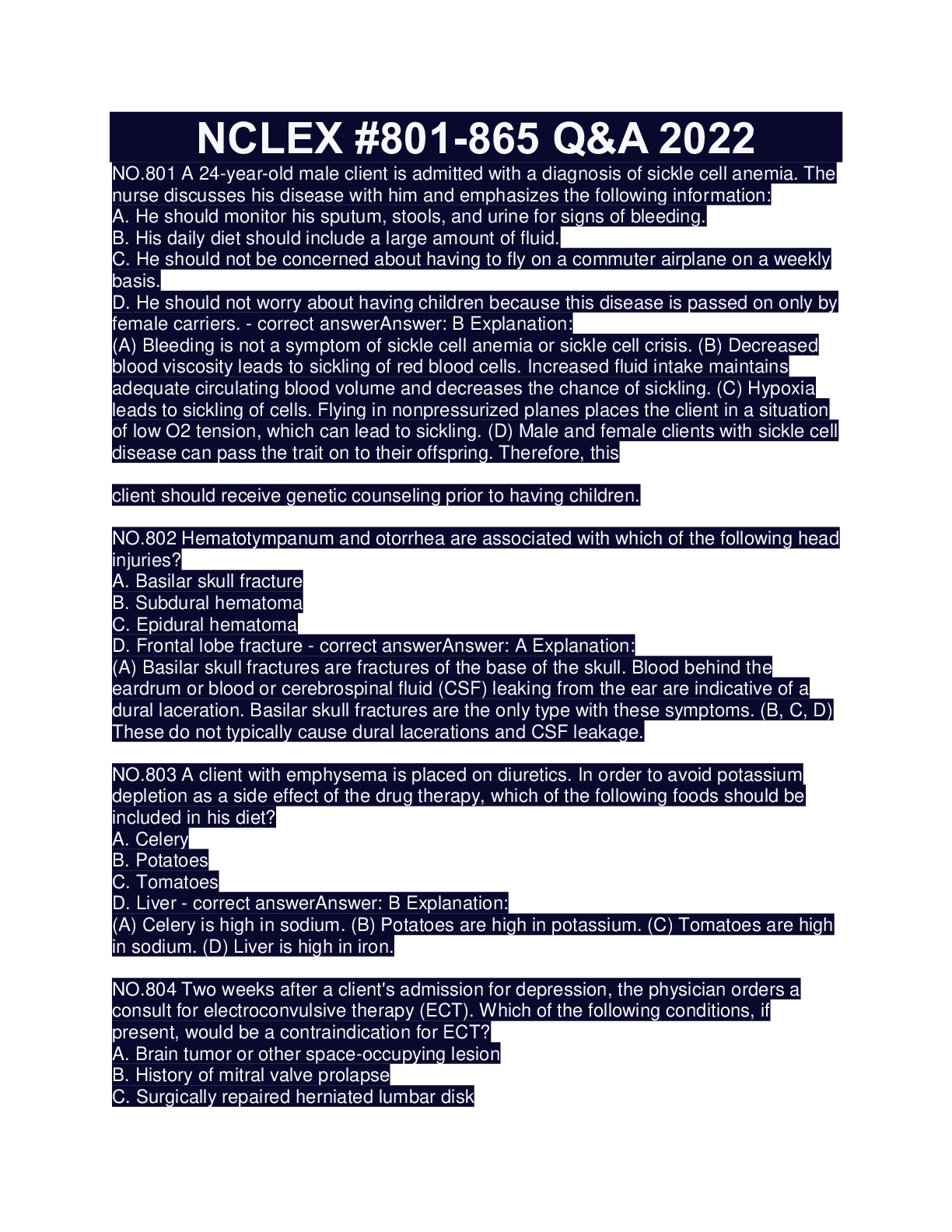
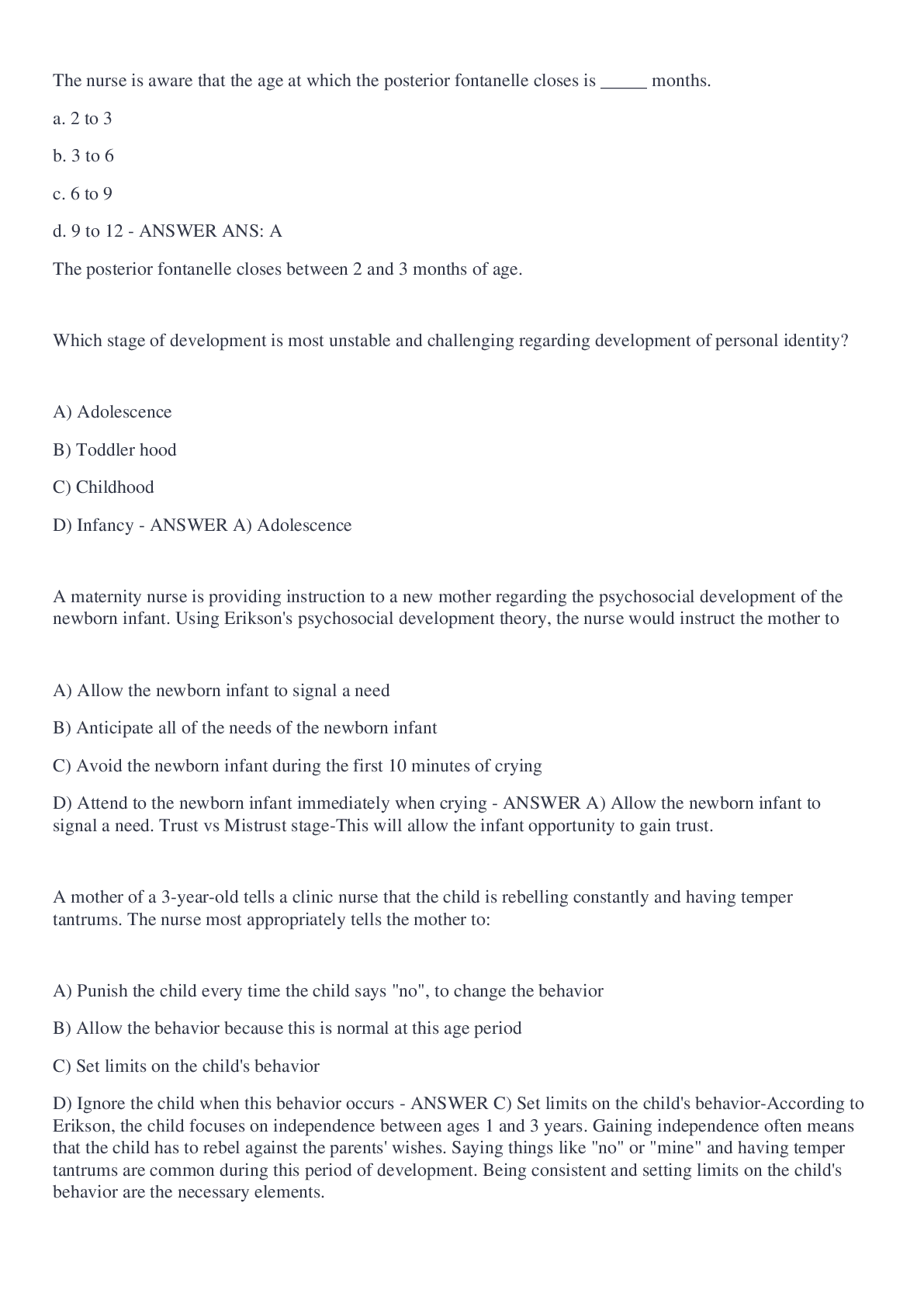

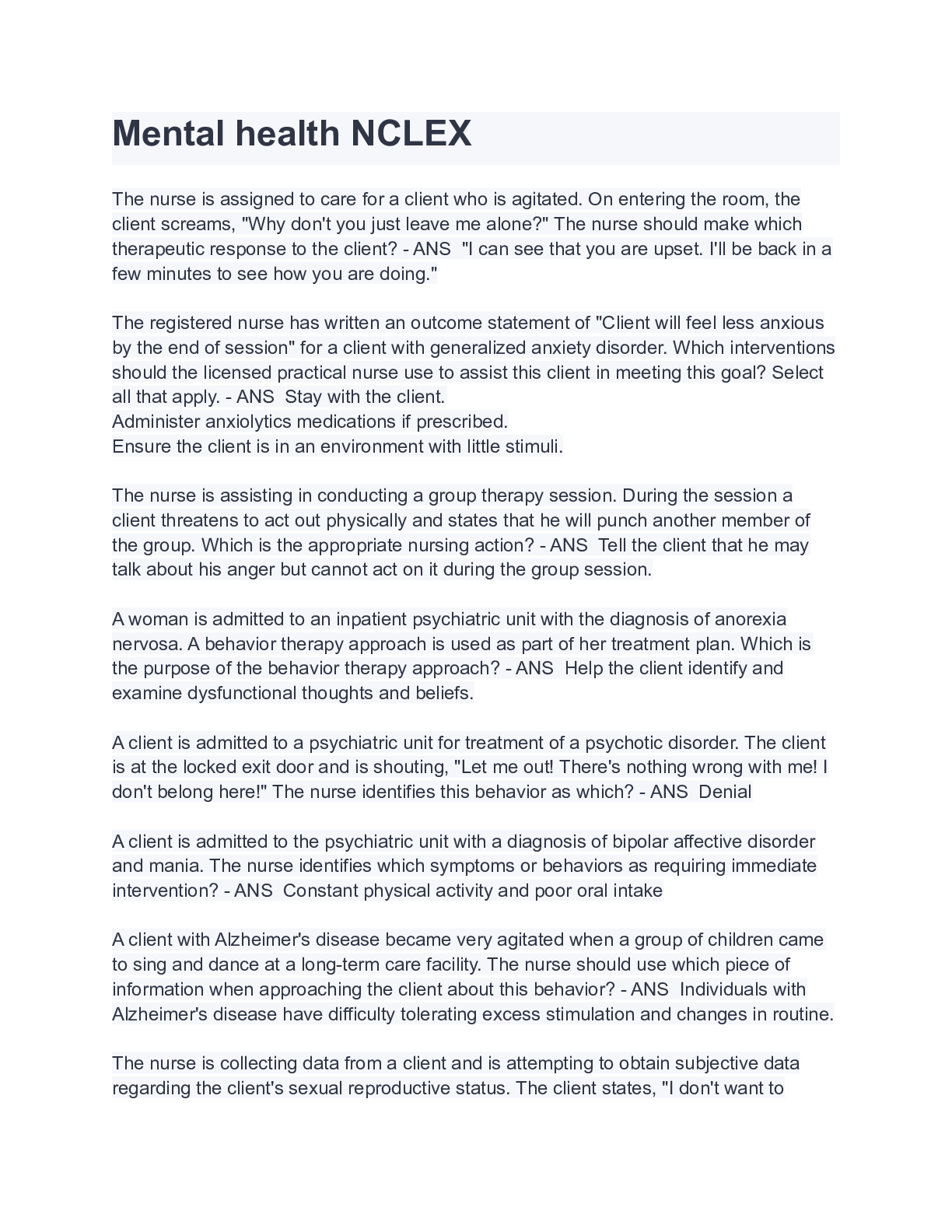
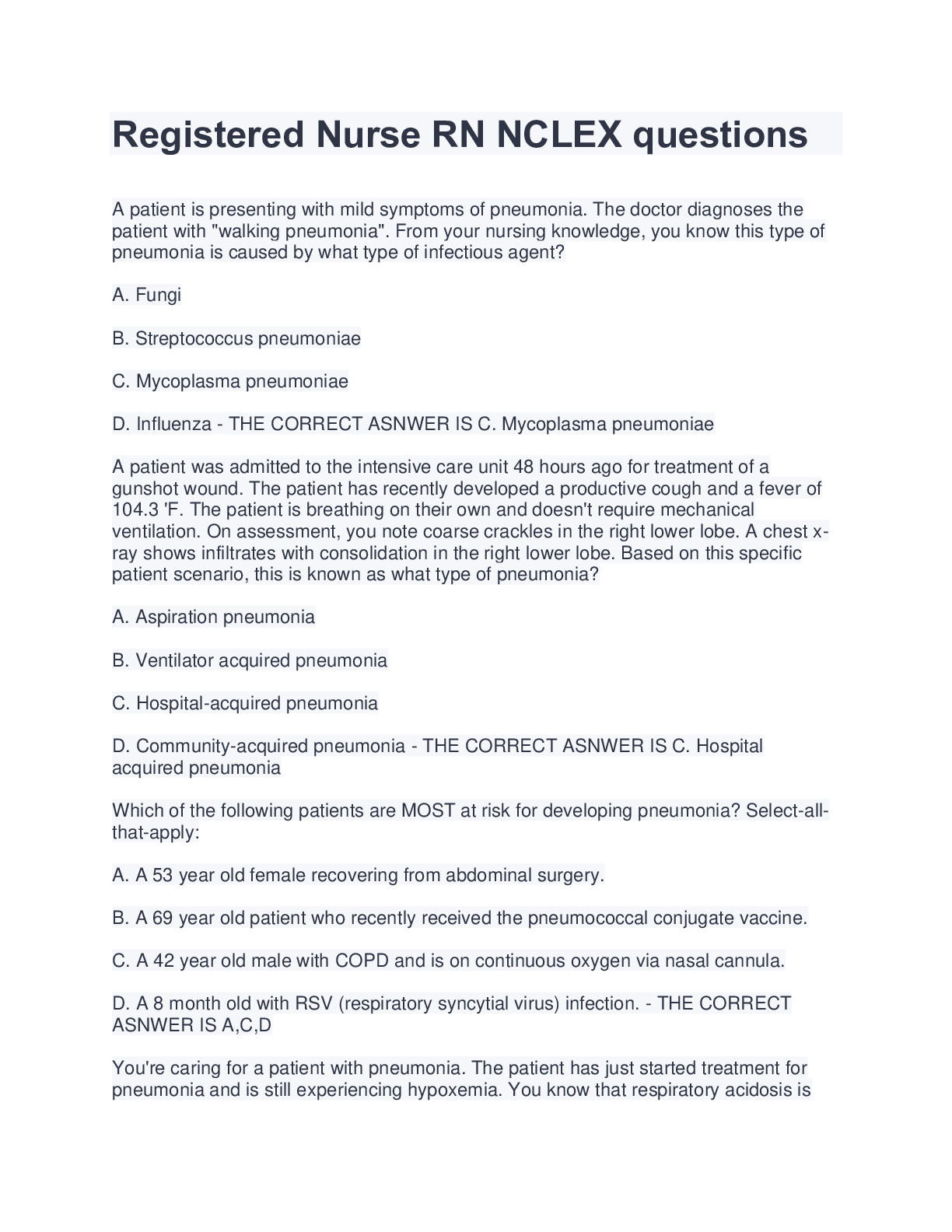
MENTAL HEALTH.png)
 (1).png)
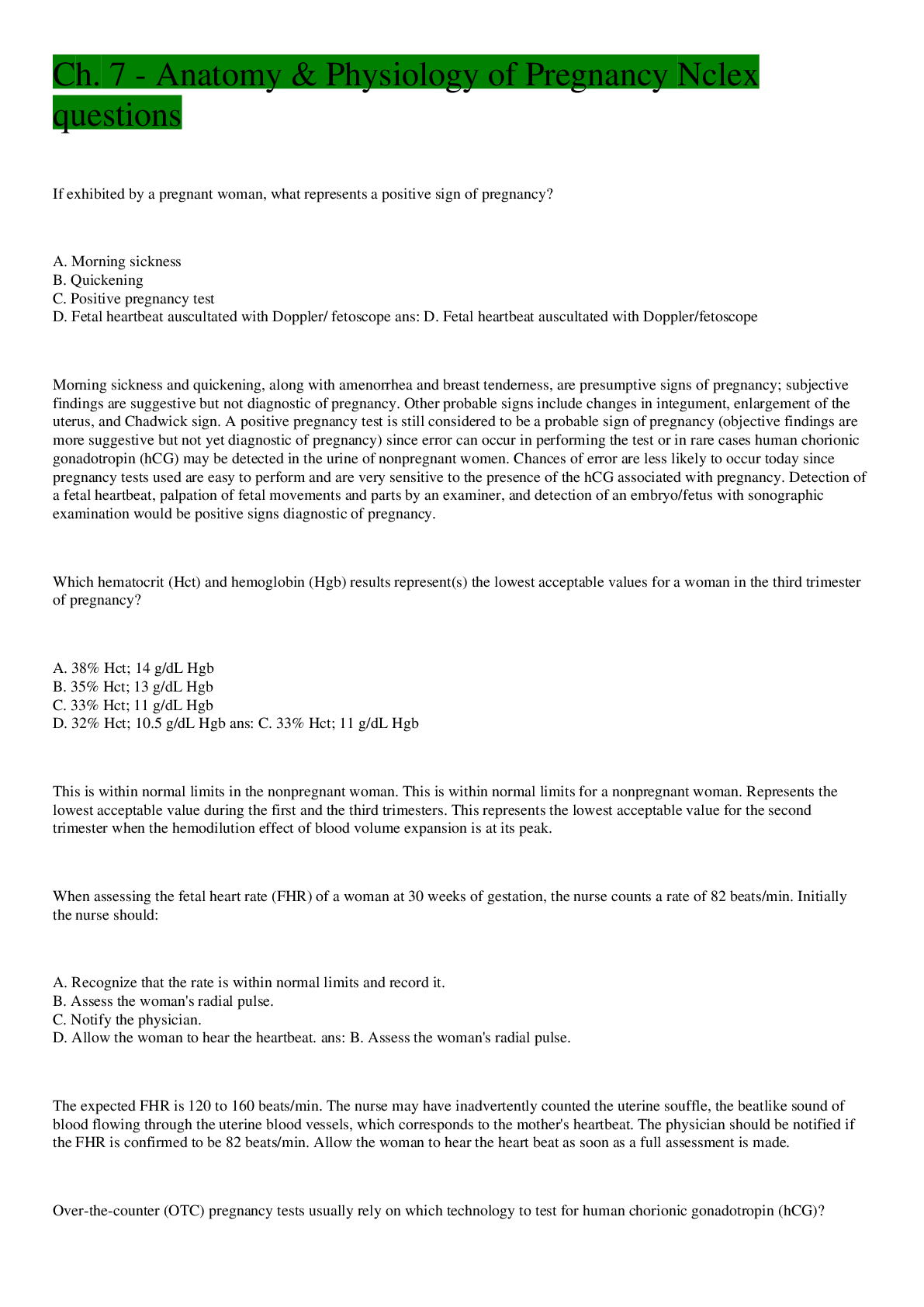

 (1).png)
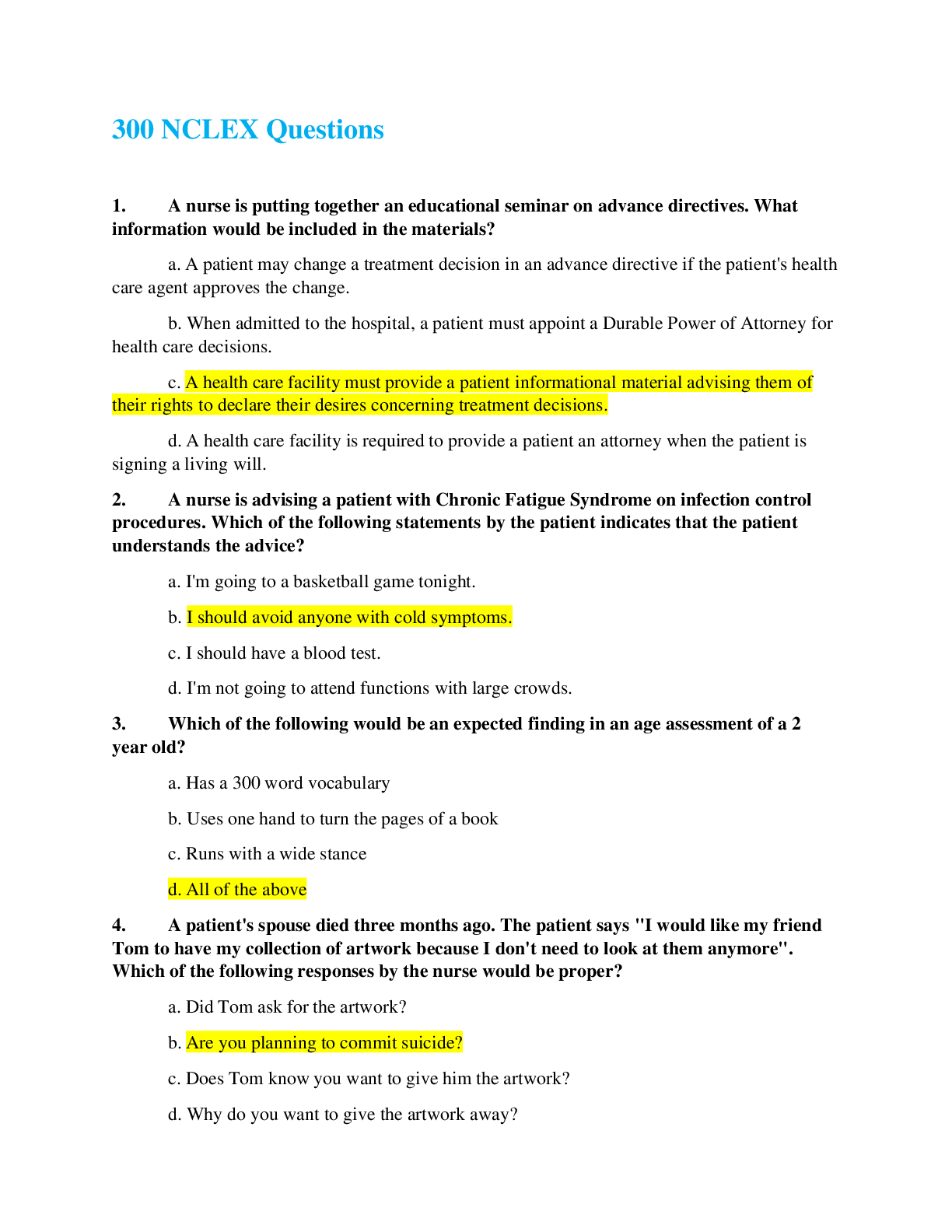
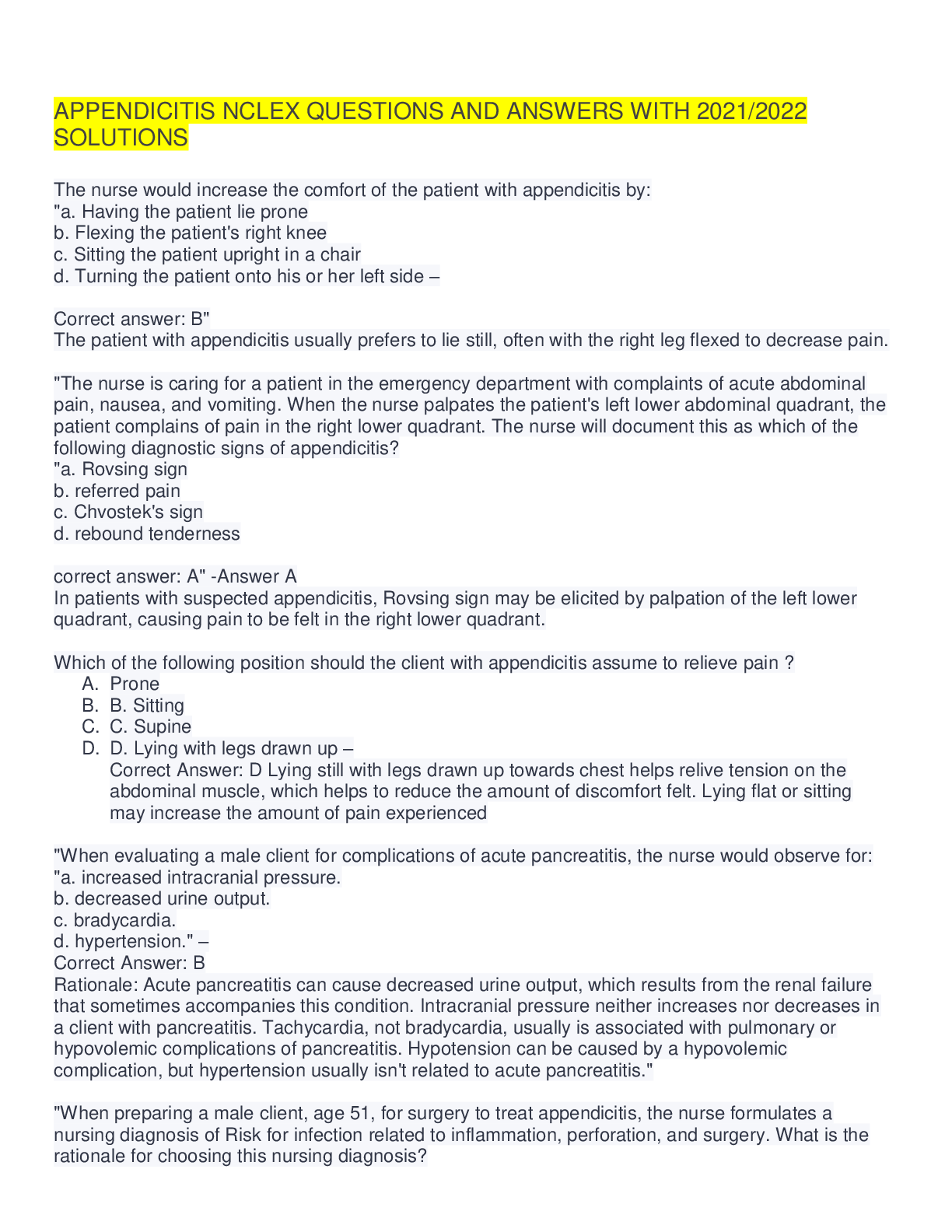

 (1).png)

 NCLEX Questions.png)
 (1).png)
